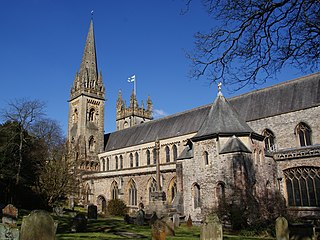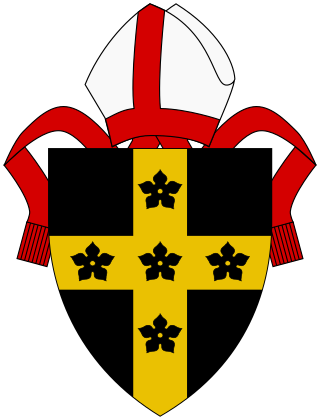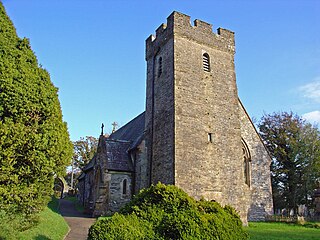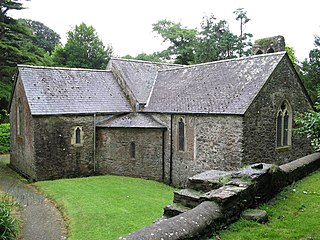Gallery
- St Ishmael's church, Pembrokeshire
- St. Ismael's Church, Uzmaston.
- St Ishmael's parish church, Camrose
Saint Ismael | |
|---|---|
| Bishop of Rhos | |
| Feast | June 16 [1] June 25 (at Uzmaston [1] ) |
| Patronage | St. Ishmael's in Pembrokeshire and Carmarthenshire; Rhos |
Isfael or Ismael (Old Welsh : Ysmail), often anglicised as Ishmael, was a 6th-century medieval Welsh bishop of Rhos and saint. He was allegedly also a Breton prince of Armorica.
Although his anglicized name invites association with the Biblical Ishmael, [2] [3] Isfael is actually a native Welsh name [1] (or even epithet) meaning 'under prince'. [4]
Isfael was said to have been the son of Budig ap Cybydan, a native of Cornouaille and eventual king of Armorica, and the brother of the martyr Tyfei and Bishop Euddogwy (Oudoceus) of Llandaff. [5] His mother may have been Arianwedd or Anowed, the sister of Saint Teilo. [6] In Rhygyfarch's hagiography, Isfael was said to have been one of the three principal disciples of Dewi Sant; [3] [7] [8] in the Book of Llandaff, he is also included among the students of Dubricius and Teilo [5] and said to have succeeded David as the bishop of Menevia (St David's). (Since he does not appear in that parish's records, it was Rees's opinion that he was at most a suffragan bishop under Teilo. [5] ) His eventual see was in Rhos at present-day St Ishmaels.
The parish churches of St Ishmael's in Pembrokeshire and Carmarthenshire and their surrounding communities are named in his honour. He was also the patron of the churches at Camrose, Rosemarket, Uzmaston, and (probably) Haroldston St Issells. [1] A valley or inlet in Carmarthen Bay was previously known as "St. Ismael's Scar". [9]

David was a Welsh bishop of Mynyw during the 6th century. He is the patron saint of Wales. David was a native of Wales, and tradition has preserved a relatively large amount of detail about his life. His birth date, however, is uncertain: suggestions range from 462 to 512. He is traditionally believed to be the son of Non and the grandson of Ceredig ap Cunedda, king of Ceredigion. The Welsh annals placed his death 569 years after the birth of Christ, but Phillimore's dating revised this to 601.

Llandaff Cathedral is an Anglican cathedral and parish church in Llandaff, Cardiff, Wales. It is the seat of the Bishop of Llandaff, head of the Church in Wales Diocese of Llandaff. It is dedicated to Saint Peter and Saint Paul, and three Welsh saints: Dubricius, Teilo and Oudoceus. It is one of two cathedrals in Cardiff, the other being the Roman Catholic Cardiff Metropolitan Cathedral in the city centre.

The Bishop of Llandaff is the ordinary of the Church in Wales Diocese of Llandaff.

The Diocese of St Davids is a diocese of the Church in Wales, a church of the Anglican Communion. The diocese covers the historic extent of Ceredigion, Carmarthenshire and Pembrokeshire, together with a small part of western Glamorgan. The episcopal see is the Cathedral Church of St David in the City of St Davids, Pembrokeshire. The present cathedral, which was begun in 1181, stands on the site of a monastery founded in the 6th century by Saint David.

Camrose is a village, parish and community in the historic cantref of Roose in Pembrokeshire, Wales. The community includes the villages of Keeston and Wolfsdale. Since 1987 the parish has been expanded to include the whole historic parish of Lambston and parts of Haverfordwest St Martins.

Saint Oudoceus (Latin) or Euddogwy (Welsh) is generally known as the third Bishop of Llandaff in South Wales. In reality he was probably a 7th-century bishop at Llandeilo Fawr. Wendy Davies puts his episcopal reign between about 650 and 700.

The Hundred of Roose was a hundred in Pembrokeshire, Wales. It has its origins in the pre-Norman cantref of Rhos and was formalised as a hundred by the Laws in Wales Acts 1535–1542. Its area was about 102 square miles (260 km2). The area became an English "plantation" in the 12th century, part of the English-speaking Little England beyond Wales.

Clydau is a community and parish in Pembrokeshire, Wales.

St Ishmaels or St Ishmael's is a village, parish and community close to the Milford Haven Waterway in Pembrokeshire, Wales. The community comprises most of the parish of St Ishmaels and had a population of 478 at the 2011 census. The ward includes the communities of Herbrandston, Dale and Marloes and St. Brides. The community was subsequently merged with other communities and only the ward remained with the name St Ishmael's. This covers the entire peninsula with at total population at the 2011 census of 1,405.
This article is about the particular significance of the year 1812 to Wales and its people.
This article is about the particular significance of the year 1791 to Wales and its people.
Llan and its variants are a common element of Celtic placenames in the British Isles and Brittany, especially of Welsh toponymy. In Welsh the name of a local saint or a geomorphological description follows the Llan morpheme to form a single word: for example Llanfair is the parish or settlement around the church of St. Mair. Goidelic toponyms end in -lann.

The Bishop of St Davids is the ordinary of the Church in Wales Diocese of St Davids.
Llandeilo Llwydarth or Llandilo is an ancient area and parish in the Preseli Hills between Llangolman and Maenclochog in the community of Maenclochog, Pembrokeshire, Wales.

Saint Teilo, also known by his Cornish name Eliud, was a British Christian monk, bishop, and founder of monasteries and churches. He was from Penalun (Penally) near Tenby in Pembrokeshire, south Wales.
Budic II, formerly known as Budick, was a king of Cornouaille in Brittany in the late 5th and early 6th centuries. He was father of Hoel as well as several Celtic saints.

Fagan, also known by other names including Fugatius, was a legendary 2nd-century Welsh bishop and saint, said to have been sent by the pope to answer King Lucius's request for baptism and conversion to Christianity. Together with his companion St Deruvian, he was sometimes reckoned as the apostle of Britain.
Saint Ishmael may refer to:

Saint Issel or Issell was a 6th-century Welsh saint in Celtic Christianity. He lived in the Kingdom of Dyfed and is principally notable as being the father of Saint Teilo.
This article is about the particular significance of the year 1729 to Wales and its people.